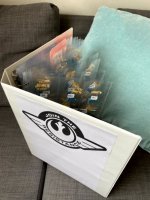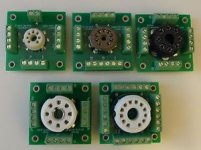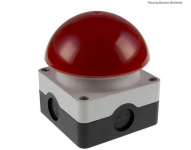Greetings!
So I decided to study tube amps and along with reading I would like to perform some experiments. Could more experienced eye look on my parts list and give some insights on what is missing?
The purpose of this is to learn and gather experience along the way. Any advice and suggestions will be greatly appreciated!
Tubes
6N2P, 6J32P, 6N14P, 6N3C
Capacitors
Polypropylene: 470pF, (1, 2.2, 4.7, 10, 22, 47)nF, (0.1,0.22,0.68)uF 630V
Electrolytics: (10, 22, 33, 47, 100, 220)uF - 450V, (47, 100, 220, 470)uF - 100V
Resistors
Metal film 1W 5%: 100, 470, 1K, 4.7k, 10k, 47k, 100k, 220k, 470k, 1M
Other
1n4148, hlmp-6000 LED
So I decided to study tube amps and along with reading I would like to perform some experiments. Could more experienced eye look on my parts list and give some insights on what is missing?
The purpose of this is to learn and gather experience along the way. Any advice and suggestions will be greatly appreciated!
Tubes
6N2P, 6J32P, 6N14P, 6N3C
Capacitors
Polypropylene: 470pF, (1, 2.2, 4.7, 10, 22, 47)nF, (0.1,0.22,0.68)uF 630V
Electrolytics: (10, 22, 33, 47, 100, 220)uF - 450V, (47, 100, 220, 470)uF - 100V
Resistors
Metal film 1W 5%: 100, 470, 1K, 4.7k, 10k, 47k, 100k, 220k, 470k, 1M
Other
1n4148, hlmp-6000 LED
Last edited:
Hello,
Ooh ooh ooh,
There are a lot of things missing.
Tube sockets, all kind of connectors.
A lightbulb safety device!!
A power supply.
What you could do is find and old fashioned regulated high voltage supply like Philips used to make.
Which country do you live?
You could start with buying an old tube amp or a radio with tubes.
Greetings, Eduard
Ooh ooh ooh,
There are a lot of things missing.
Tube sockets, all kind of connectors.
A lightbulb safety device!!
A power supply.
What you could do is find and old fashioned regulated high voltage supply like Philips used to make.
Which country do you live?
You could start with buying an old tube amp or a radio with tubes.
Greetings, Eduard
Thanks for a quick reply!
Actually, I have HT power supply 0-600V 600mA, variable transformer with isolation transformer and lightbulb in series with mains, DMM, function generator and oscilloscope.
So I think, I am all set for now with safety and measuring equipment.
Tube socket. What type I should buy? Are there any suitable for breadboarding?
Actually, I have HT power supply 0-600V 600mA, variable transformer with isolation transformer and lightbulb in series with mains, DMM, function generator and oscilloscope.
So I think, I am all set for now with safety and measuring equipment.
Tube socket. What type I should buy? Are there any suitable for breadboarding?
I got two 500-packs of 1W metal film resistors from Aliexpress for next to nothing. They're just for experimenting and spares, I usually buy higher quality resistors specifically for my projects, but now I have all the values I'll ever need (and quite a few I won't need).
I've put them in a ring binder to organize them:

I've put them in a ring binder to organize them:

That's a thought! At this point I am thinking of buying polypropylene capacitors and resistors kits from Aliexpress just for experimenting.I got two 500-packs of 1W metal film resistors from Aliexpress for next to nothing.
I will upgrade when I build a real project. Not sure about electrolytics though. What do you guys think?
Btw, "join the resistance" logo is very cool!
You may want another higher value in HV electrolytics, depending on what PSU you are making. Nothing wrong really the values are useful.
If you're following a design and you've got the values you expect to need then no problem.
I'd want more than 47uF total PSu capacitance though, if designing from scratch.
You can get 500V 220uF in pretty compact cans, albeit radial pinned, fairly cheaply.
Then 22/47/100uF would be good for local supply decoupling perhaps.
Some lower rated electrolytics for cathode bypass might be useful, if you go that route.
Say something in the 100V range, say between 47uf and 470uF, depending on what biasing voltage you may encounter, and the circuit. No reason to use 450V rated parts there.
If you're following a design and you've got the values you expect to need then no problem.
I'd want more than 47uF total PSu capacitance though, if designing from scratch.
You can get 500V 220uF in pretty compact cans, albeit radial pinned, fairly cheaply.
Then 22/47/100uF would be good for local supply decoupling perhaps.
Some lower rated electrolytics for cathode bypass might be useful, if you go that route.
Say something in the 100V range, say between 47uf and 470uF, depending on what biasing voltage you may encounter, and the circuit. No reason to use 450V rated parts there.
Last edited:
Thanks for a quick reply!
Actually, I have HT power supply 0-600V 600mA, variable transformer with isolation transformer and lightbulb in series with mains, DMM, function generator and oscilloscope.
So I think, I am all set for now with safety and measuring equipment.
I always put a LED in series with a resistor across my smoothing caps to show when the cap is charged. I never put my hands inside the amp when it is on.
Clip scope probe to tag and then turn on amp. Dont unclip until power LED is off.
Only one life in this game !
Thanks for the input and tips! I will update my list, according to the suggestions maybe for someone new like me this info will be handy.
What values of potentiometers are good to have on hand?
10k, 50k, 100k, 1M?
What values of potentiometers are good to have on hand?
10k, 50k, 100k, 1M?
I'd suggest that perhaps 10k potentiometer is smaller than I'd attempt to use, between amplifying stages. Using a pot at the input to attenuate signal input, and then perhaps the 10k would be more useful - I try and avoid doing volume controls this way if I can.
Perhaps 25k or 50k minimum value pot, and perhaps 1M is on the larger side of what is required (for volume/balance controls), 500k and 1M may be more useful for tone controls (again it depends on how you develop the design)
Perhaps 25k or 50k minimum value pot, and perhaps 1M is on the larger side of what is required (for volume/balance controls), 500k and 1M may be more useful for tone controls (again it depends on how you develop the design)
Thanks for a quick reply!
Actually, I have HT power supply 0-600V 600mA, variable transformer with isolation transformer and lightbulb in series with mains, DMM, function generator and oscilloscope.
So I think, I am all set for now with safety and measuring equipment.
Tube socket. What type I should buy? Are there any suitable for breadboarding?
I am missing a large "rescue mains interrupting switch" in case you accidentally "connect" yourself to the high voltage part of your circuit. You can hit it with whatever (hand/foot) to disconnect your circuit from the mains.
Great! And last thing, any particular diodes, zener diodes or maybe other semiconductors that could be useful?
I am missing a large "rescue mains interrupting switch" in case you accidentally "connect" yourself to the high voltage part of your circuit. You can hit it with whatever (hand/foot) to disconnect your circuit from the mains.
Thanks for suggestion! I will definitely incorporate that!
Rectifier diodes / bridges are useful, LM317 regulator for DC heater supplies perhaps. Zeners - difficult to stock every value but a range might be useful for experimenting with bias points, 5/10/22/56/100V perhaps? Spare cheap multimeter is useful for monitoring more circuit voltages.
An isolation transformer is much safer than relying on an emergency off switch after the event!
An isolation transformer is much safer than relying on an emergency off switch after the event!
^+1
Also 1N53xx range of 3W zener diodes may be useful, screen regulation perhaps, if you use a tetrode/pentode.
24V is quite a useful value for strings like this, spreading dissipation over several diodes.
Other devices I am/will use/using, would be LND150, DN2540, BC547/557/560, ZTX558, MJE350 for some CCS, with some J113 I bought to try out. The BC, ZTX, may or may not be useful for everyone.
Most get away with just using DN2540 as a CCS, perhaps 2 in cascode.
10M45 is also used alot by folks here, but I havent bothered with it as I have quite a few options here alresdy
Also 1N53xx range of 3W zener diodes may be useful, screen regulation perhaps, if you use a tetrode/pentode.
24V is quite a useful value for strings like this, spreading dissipation over several diodes.
Other devices I am/will use/using, would be LND150, DN2540, BC547/557/560, ZTX558, MJE350 for some CCS, with some J113 I bought to try out. The BC, ZTX, may or may not be useful for everyone.
Most get away with just using DN2540 as a CCS, perhaps 2 in cascode.
10M45 is also used alot by folks here, but I havent bothered with it as I have quite a few options here alresdy
Last edited:
100, 470, 1K, 4.7k, 10k, 47k, 100k, 220k, 470k, 1M
A 1-5-10 sequence is NOT enough for "experiment". Where is your 220 and 2k2? And 33 and 68? Yeah, you can putz-together other resistors but 1W metal-film doesn't grow on trees (not my trees).
A set of 10ea or 100ea of ALL the 5% values in 1/2W carbon-film is really inexpensive (in context of tube-play) and you will always have a close-enough value for any tube-work. When you find a happy op-point you can order-in metal-film for slick sound and/or 1W/2W for longer life.
Almost all the online component suppliers offer free delivery over a certain price point, something like $50. When I buy from Digi-Key I chuck in a Triad choke which is cheap but heavy.
I’ve accumulated a good selection of parts for my ‘parts bin’ just by capitalizing on the mult-buy price breaks. So 100 UF4007 instead of 4 or 10.
Resistors crop up on auction sites, so I primed my parts bin with a full E22 set, 0.6W, 1% metal film, 10 of each value. Also I have had bulk buys for LEDs and regulators from that site.
Otherwise it is very difficult to second guess all the combinations of voltage and capacitance, or resistance and power handling, or zener parameters, etc. Better to consider the project first IMO.
Do you have an idea of what your first investigation will be? Will you be hoping to package it properly once it is working well? Would you consider starting with a PCB, to develop construction skills?
I’ve accumulated a good selection of parts for my ‘parts bin’ just by capitalizing on the mult-buy price breaks. So 100 UF4007 instead of 4 or 10.
Resistors crop up on auction sites, so I primed my parts bin with a full E22 set, 0.6W, 1% metal film, 10 of each value. Also I have had bulk buys for LEDs and regulators from that site.
Otherwise it is very difficult to second guess all the combinations of voltage and capacitance, or resistance and power handling, or zener parameters, etc. Better to consider the project first IMO.
Do you have an idea of what your first investigation will be? Will you be hoping to package it properly once it is working well? Would you consider starting with a PCB, to develop construction skills?
Thanks for suggestion! I will definitely incorporate that!
I mean this one:
Attachments
Two of the things I find useful for experimenting with tubes -- an old Eico or Heathkit VTVM -- for poking around power supplies, and a variac. Thrift stores and Craig's List are good sources. One "Habitat for Humanity" store had a Tektronix 2215 scope which they were trying to rid themselves of for $15.
Last edited:
- Home
- Amplifiers
- Tubes / Valves
- buying parts for tube circuit experiments

